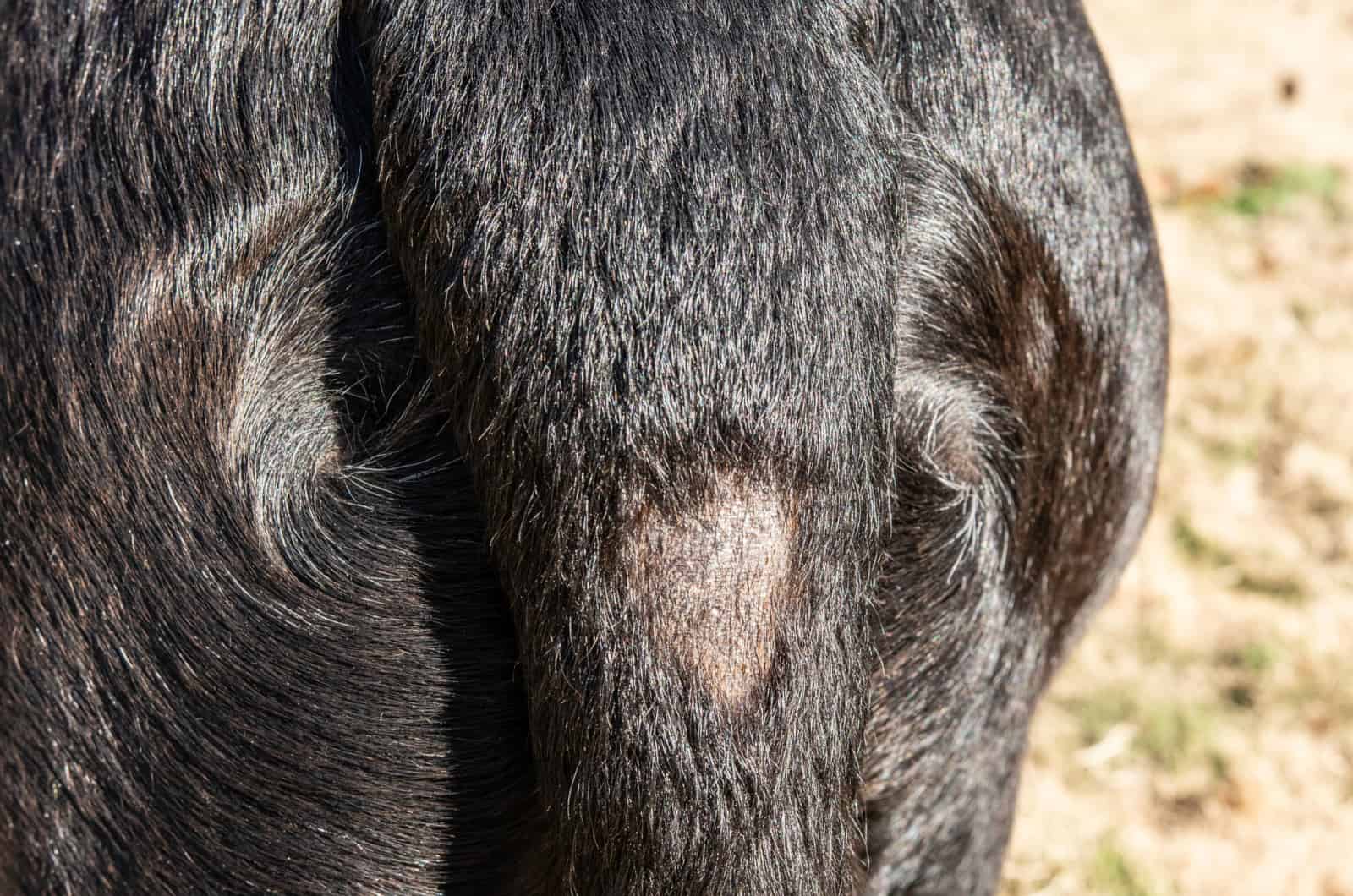We’ve all seen all sorts of weird things when it comes to our canine companions, but what about that weird bald spot on the dog’s tail? Why does stud tail in dogs show up at all?
You’ll be happy to know that stud tail in dogs isn’t really all that concerning, but can be a little bit unsightly and it usually happens due to gland irritation on a specific spot on the tail.
For wild species of canids, it’s the so called violet gland that’s at fault as it produces an excess amount of pheromones and oils which can irritate the hairs on the tail and cause them to fall out.
For dogs, it’s because each gland on their tail has a single hair follicle, and should one get irritated, it’s prone to falling out and creating a bald spot.
There are a few factors that contribute to the creation of a stud tail in dogs, mostly related to hormonal imbalances or things like Cushing’s disease.
There aren’t any really concerning side-effects to having a stud tail, but it on its own can be an indicator that there are some underlying health issues that may need to be addressed.
To find out more about the appearance of this bald spot on a dog’s tail, what it means, how to treat it, as well as answers to some of the more closely related questions to the topic. Be sure to read on.
Why Does Stud Tail In Dogs Even Show Up?
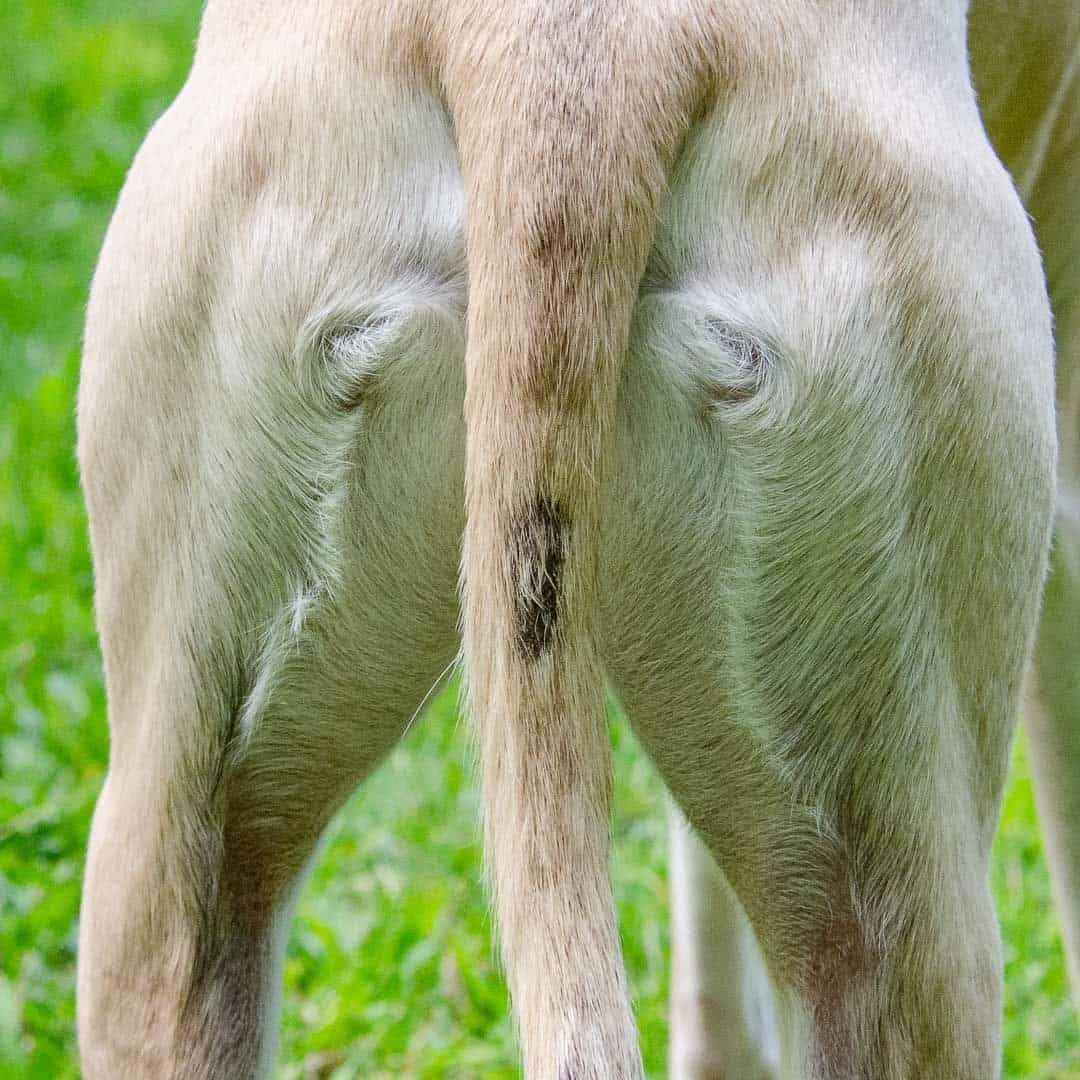
As mentioned a little earlier, stud tail essentially represents a bald spot on your dog’s tail, one that doesn’t appear through sheer happenstance, but rather due to a gland that’s stayed there from their ancestors.
The spot is always an inch or two from the base of the tail, around where you’ll find the supracaudal tail gland, also known as the violet gland in wild canids or the oval tail gland due to its shape.
It’s usually right above the 9th caudal vertebrae, hence the name supracaudal gland.
The reason why the bald spot shows up is due to the high concentration of sweat and sebaceous glands on this specific area which produce a lot of sweat and oily secretions as its main intent was to emit pheromones.
When the spot gets irritated due to tail gland hyperplasia or supracaudal gland hyperplasia, these glands start working overtime and produce way more sweat and oils (sebum to be specific) than is needed, further irritating the area.
The effect occurs due to high androgen levels in the area over a long period of time which negatively start affecting the fur and skin in the area.
This can then potentially lead to hair loss, hair matting, the oils and sweat can clog up hair glands and appear as small, dirty black plugs.
This, in turn, can also be a gateway to other skin infections on the afflicted area which then can make this issue even more bothersome.
What Is Sebum?
Sebum is the oily mass that sits around hair follicles, that bit that gives it the right amount of greasiness to help keep it nice, soft and durable.
Excess production of said Sebum is one of the main causes of stud tail in dogs and brings with it a rather unpleasant smell which is easily noticeable when your dog is affected by this condition.
What Else Can Create The Bald Spot On The Tail?
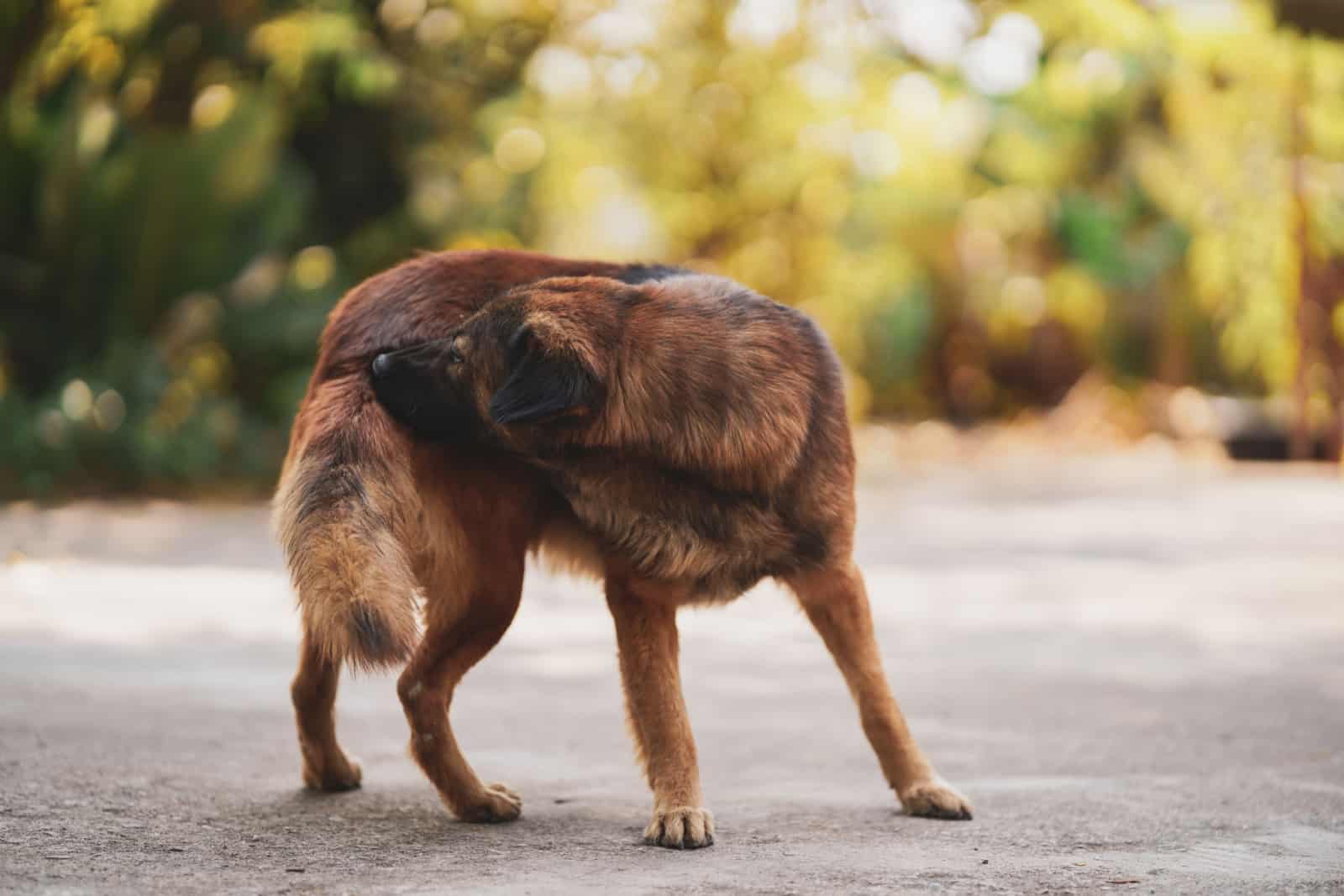
The other cause of stud tail can be fleas.
Fleas are often attracted to areas of the skin that produce a large amount of oils, and this patch is perfect for them, not so much for your dog as the area is more likely to get inflamed and sprout a hot spot.
He’ll then proceed to scratch away at said spot which will only make the bald spot form faster and grow bigger.
Why Does The Fur Fall Out?
Well, the irritation itself is the main cause of hair loss in dogs on this specific spot.
Also, unlike the body which has the primary guard hair and up to a dozen downy hairs to replace themselves should one fall out, the hair follicles on the gland only have the guard hair with no downy hairs.
This means that if a skin condition were to affect this particular area, the hair is likely to fall out with no replacement, which then leads to the aforementioned bald spot manifesting around the affected area.
What Are The Known Symptoms?
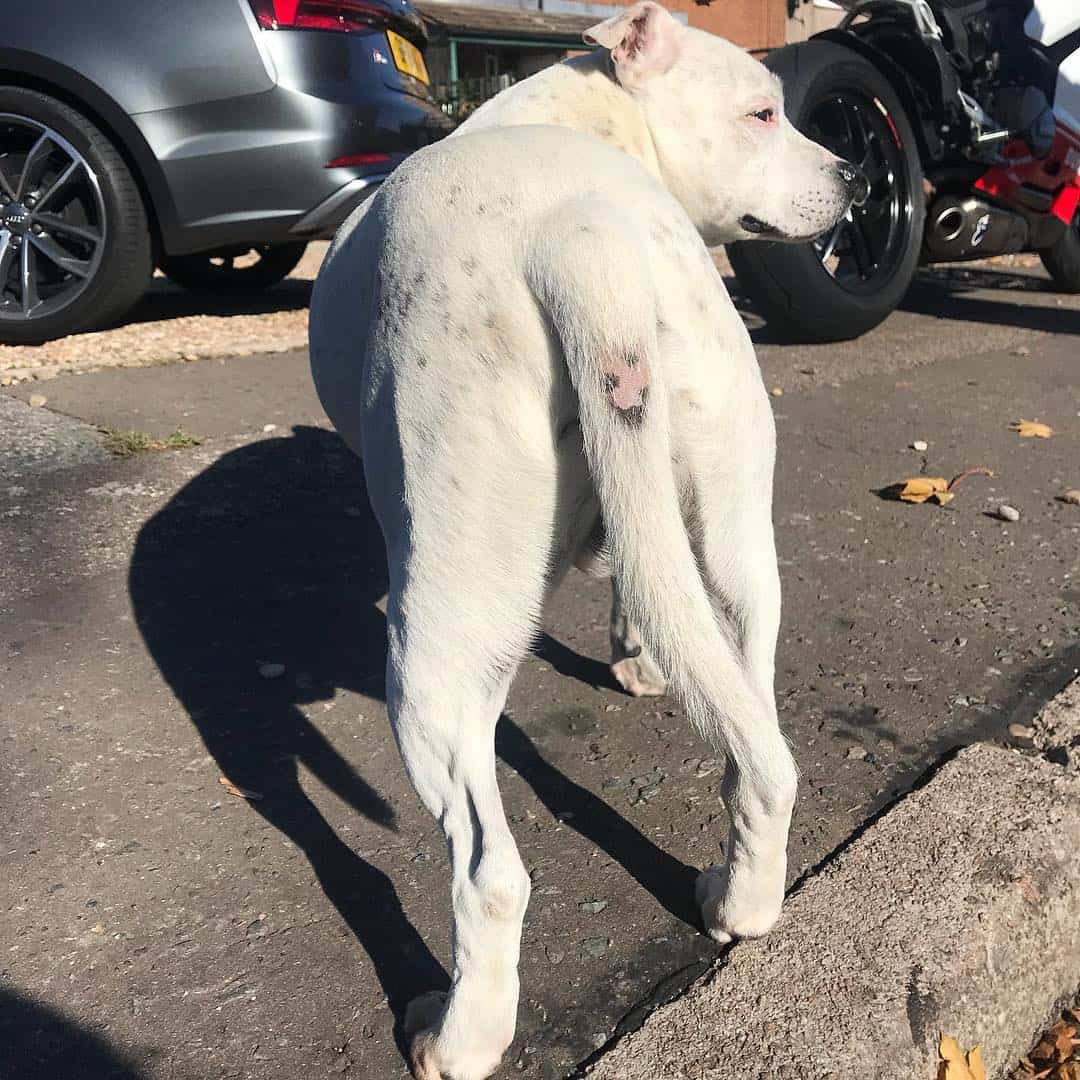
Many people wonder how one can tell stud tail in dogs apart from other skin irritation issues and fur conditions.
Thankfully, there are a few easy to discern symptoms that’ll let you know it’s merely just stud tail and not something more serious.
Keep in mind that the symptoms are similar to some of the other skin diseases out there, but should you spot any of these in combination with one another, it’s good to call your vet to confirm that it actually is stud tail.
Some of the most common symptoms of stud tail are:
- Missing hair on the specific spot at the base of the tail
- Overly greasy hair from the sebum oily substance
- Clogged follicles and pores (blackheads) in the affected area
- A rancid smell from the abundance of sweat and oil secretions excreted
- Some form of rash or skin infection in the affected area
- A waxy film covering the surrounding hair and the bald spot
Again, while not exactly dangerous, it’ll get more uncomfortable for the dog the more it’s left untreated, so take him to the vet as soon as you see some of the symptoms pop up to get prescribed the necessary treatment options.
This way you avoid any further bacterial infections from emerging on the afflicted area.
What Are The Most Common Treatment Options?
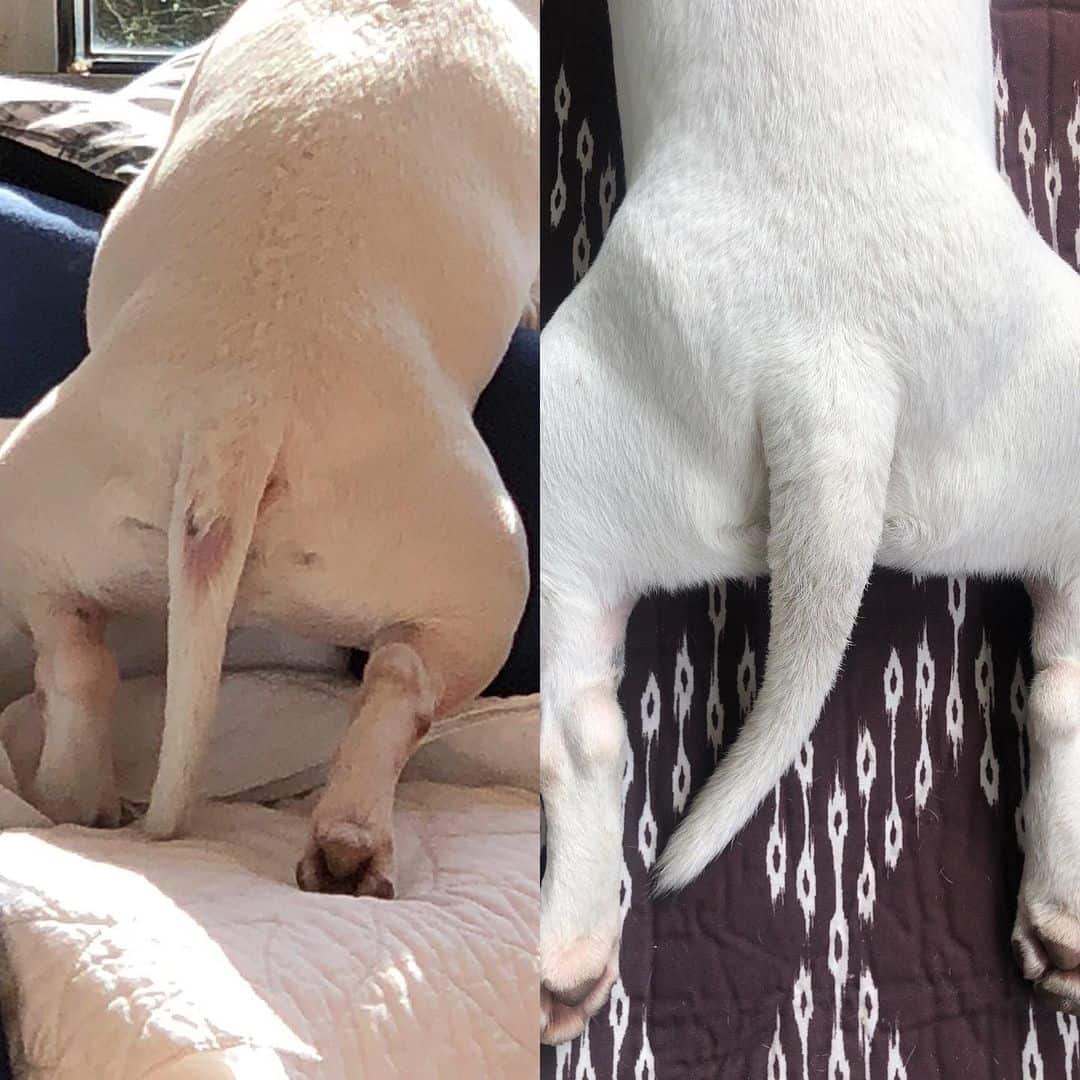
Usually, you’ll get recommended a specific, antiseborrheic shampoo to improve your dog’s health.
One that has Benzoyl peroxide as an ingredient, an antibacterial concoction used to clear out the formed blackheads and open up the follicles so the skin can breathe.
It also helps normalize the excretion of these oily substances to reduce the intensity of the symptoms.
Aside from Benzoyl peroxide, you’ll want to look for another ingredient called salicylic acid, a known canine friendly exfoliant to improve your dog’s overall skin health.
Other than shampoos, topical creams are going to be another suggestion which will contain similar ingredients.
Arguably easier to put on the hot spot than giving your doggo a bath, but it depends on the vet’s treatment decision.
If none of these are available locally, you’ll more than likely be able to find the products on sites like Amazon or Chewy if they’re over-the-top meds, otherwise you’ll need to visit your local pharmacy to get them.
An option, in case you own a male dog, is neutering if he hasn’t been neutered yet, especially if it’s a recurring problem and if hormones are the main cause of the issue.
It’ll help in many other aspects of your dog’s life, be it his temperament or his overall health with the latter being the reason for the procedure here.
However, let your doctor advise you on what the best course of action is before making such a drastic change.
Is There Anything Else I Can Use?

While it won’t help with getting rid of the problem, getting something that can help hydrate dry and irritated skin like coconut oil into the mix can at least help numb the itchiness and improve overall skin quality ever so slightly.
But again, just like with the medicated shampoo and the topical creams, you need to ask your doctor if it’s okay to use said product for your dear doggo’s specific condition.
Is This A Permanent Condition?
Not at all. As I said, it’s mostly a glandular problem left over from the dog’s wild canid ancestors and has plenty of treatment options to mitigate its effects and have it cease altogether.
However, it will likely take a week or two at the very least to see tangible results.
It can always come back, sure, but it never stays for long if treated right away.
Can The Condition Jump To Another Dog?

Thankfully, it can’t. It’s not that kind of infection as it has more to do with messing up your dog’s immune system in particular.
There are no viruses that can jump ship to another dog due to proximity or otherwise, so, if you have more than one pooch or your pet has a furry friend, they should be safe to hang around him.
Do Male And Female Dogs Get Affected Equally?
They do. The symptoms are about the same for both genders and have an almost equal chance of occurring in intact males and females.
The one outlier are unneutered male dogs which appear to be affected more than any other groups.
Is There Anything Else That Predisposes A Dog To Having Stud Tail?
While it varies from breed to breed and dog to dog, there are a few different factors that can make it more likely for your dog to have this bald patch appear on his tail.
Some of the more common culprits are:
- Hormonal imbalances, especially in male dogs
- Hypothyroidism
- Other skin infections
- Allergic reactions
- Cushing’s disease
Many of these are pretty common in the canine world aside from the last one.
While it can affect every dog, certain smaller dog breeds are more prone to it than others, so all you small dog owners, especially ones with poodles, should pay close attention to your dog and any potential issues he may have.
You want him to be able to wag his tail without feeling a massive amount of discomfort after all.
How To Know If The Situation Has Developed Into A Worse State?

The differences between mild cases of stud tail and more severe ones are easy to spot.
Namely, in more severe cases, that horrible smell will start to permeate your nostrils when in vicinity of the bald spot whereas milder cases won’t really have the scent be that potent or even present whatsoever.
Aside from that, there would be more apparent redness and swelling on the affected area.
Some of the most severe cases also have other forms of moist dermatitis and other potential skin infections.
As always, if you’re not sure whether the situation has developed for the worse or if it’s still in its early stages, phone up a vet and get him to look your precious pooch over.
He’ll be able to determine whether or not the problem has gotten serious or if it’s serious enough to begin with.
Is Every Bald Spot On A Dog’s Tail A Sign Of Stud Tail?
No, which is why it’s better to contact a DVM to get a proper assessment. Sometimes a situation may look weird, but it doesn’t have to be this particular problem, but a variety of other harmless, and temporary reasons.
Some could be a lot more serious too. For example, the swelling on the bald spot could be a cancerous tumor which would need to be removed if possible.
This is usually determined through a biopsy where a small tissue sample is taken from the affected area and studied to determine whether it’s some benign swelling, hyperplasia or said tumor.
Once that’s done, the vet should follow up with further instruction.
How Long Does It Take For Stud Tail To Go Away?
Usually it takes somewhere around 1-2 weeks, if not more, depending on the severity of the issue.
It’s that way because it takes a bit of time for the hormonal imbalances to correct themselves and for the sebum production to normalize just as well.
Is There Any Other Spot On The Dog That Suffers From A Similar Problem?
There, in fact, is, and it’s near the tail area too as it’s found on the anus.
The dog’s butt contains the same sebaceous glands as the tail does and usually leads to thicker, lower quality skin around the area as the dog grows.
However, these ones don’t get inflamed as often and are usually a cause of hormonal imbalance, testosterone specifically.
In Conclusion

A stud tail in dogs may look unpleasant at first glance, but they’re not that uncommon.
They’re caused by a sebaceous gland that every other dog has. Something left over from their wilder ancestors.
It’s located above the 9th caudal vertebrae and shows up in the form of a small bald patch as that area has no downy hairs, just a singular guard hair per follicle which is why it’s more prone to hair loss than other areas.
Irritation and frequent scratching may cause it to fall out and the subsequent sebum mixed in with dirt, sweat, and other oils can plug the pores and form blackheads.
Thankfully, this condition on its own is nothing to worry about aside from the aesthetic as it’s very easy to treat with simple, over the counter medicated shampoos and topical creams.
The worst part of it that you’ll have to experience is the nasty smell that the sebum leaves if the condition hasn’t been treated immediately and left to fester, for lack of a better term.
The condition has a chance to affect every dog equally, but unneutered male dogs have shown a few more results where they seemed to wind up with this condition the most.
I hope you’ve managed to learn something new today and that I’ve helped you treat your dog well. Until next time.
And remember, not every form of hair loss immediately leads to a stud tail. Ask your vet before undertaking anything more drastic.
RELATED LINKS:
